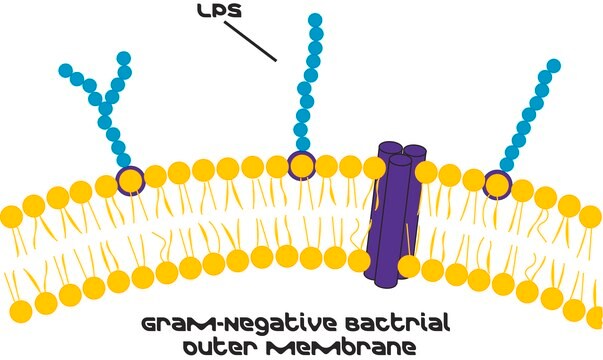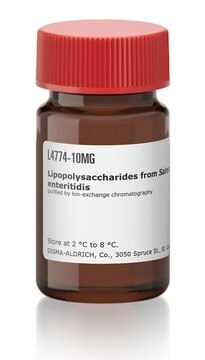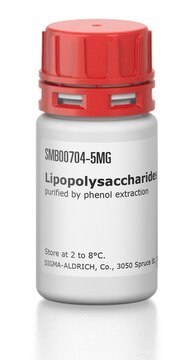추천 제품
생물학적 소스
Salmonella enterica (Serotype enteritidis)
Quality Level
양식
lyophilized powder
정제법
gel-filtration chromatography
불순물
<1% Protein
색상
white to faint yellow
solubility
water: 4.90-5.10 mg/mL, cloudy to hazy, colorless to faintly yellow
배송 상태
ambient
저장 온도
2-8°C
유사한 제품을 찾으십니까? 방문 제품 비교 안내
일반 설명
This product is extracted from Salmonella enteritidis and purified by gel filtration. The source strain is ATCC 13076. Lipopolysaccharide from Salmonella enteritidis is mutagenic in murine spleen cells and causes a plaque-forming response in those cells.
애플리케이션
Lipopolysaccharides (LPSs) are characteristic components of the cell wall of Gram-negative bacteria. LPS and its lipid A moiety stimulate cells of the innate immune system by the Toll-like receptor 4 (TLR4).
생화학적/생리학적 작용
Lipopolysaccharides (LPS) are localized in the outer layer of the membrane and are, in noncapsulated strains, exposed on the cell surface. They contribute to the integrity of the outer membrane, and protect the cell against the action of bile salts and lipophilic antibiotics.
제조 메모
The product is soluble in water (5 mg/ml) or cell culture medium (1 mg/ml) yielding a hazy, faint yellow solution. A more concentrated, though still hazy, solution (20 mg/ml) has been achieved in aqueous saline after vortexing and warming to 70-80 oC. Lipopolysaccharides are molecules that form micelles in every solvent. Hazy solutions are observed in water and phosphate buffered saline. Organic solvents do not give clearer solutions. Methanol yields a turbid suspension with floaters, while water yields a homogeneously hazy solution.
기타 정보
To gain a comprehensive understanding of our extensive range of Lipopolysaccharides for your research, we encourage you to visit our Carbohydrates Category page.
관련 제품
제품 번호
설명
가격
Storage Class Code
11 - Combustible Solids
WGK
WGK 3
Flash Point (°F)
Not applicable
Flash Point (°C)
Not applicable
이미 열람한 고객
Laman K Mamedova et al.
The Journal of nutritional biochemistry, 24(8), 1499-1507 (2013-03-08)
Saturated free fatty acids (FFA) can activate inflammatory cascades including the toll-like receptor 4 (TLR4) pathway. TLR4 is expressed by hepatocytes and may help link FFA to altered hepatic gluconeogenesis in type 2 diabetes mellitus. This study examined the role
Basilia Zingarelli et al.
Immunology, 124(1), 51-57 (2007-11-22)
Peroxisome proliferator activated receptor-gamma (PPARgamma) has been reported to exert anti-inflammatory properties in endotoxic shock and sepsis. One phenomenon that alters the inflammatory response to endotoxin [lipopolysaccharide (LPS)] is endotoxin tolerance, which is caused by previous exposure to endotoxin. Here
A Zarbock et al.
British journal of pharmacology, 155(3), 357-364 (2008-07-01)
Acute lung injury (ALI) remains a major challenge in critical care medicine. Both neutrophils and chemokines have been proposed as key components in the development of ALI. The main chemokine receptor on neutrophils is CXCR2, which regulates neutrophil recruitment and
Jörg Reutershan et al.
European journal of immunology, 39(6), 1597-1607 (2009-06-06)
The Duffy antigen receptor for chemokines (DARC) has a high affinity for CC and CXC chemokines. However, it lacks the ability to induce cell responses that are typical for classical chemokine receptors. The role of DARC in inflammatory conditions remains
Graciliana Lopes et al.
PloS one, 7(2), e31145-e31145 (2012-02-10)
Bacterial and fungal infections and the emerging multidrug resistance are driving interest in fighting these microorganisms with natural products, which have generally been considered complementary to pharmacological therapies. Phlorotannins are polyphenols restricted to brown seaweeds, recognized for their biological capacity.
자사의 과학자팀은 생명 과학, 재료 과학, 화학 합성, 크로마토그래피, 분석 및 기타 많은 영역을 포함한 모든 과학 분야에 경험이 있습니다..
고객지원팀으로 연락바랍니다.

